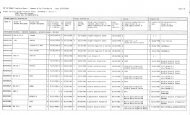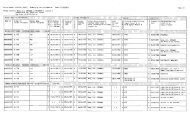Meet Mr. Porpoise - Ceta-Base
Meet Mr. Porpoise - Ceta-Base
Meet Mr. Porpoise - Ceta-Base
You also want an ePaper? Increase the reach of your titles
YUMPU automatically turns print PDFs into web optimized ePapers that Google loves.
to have a complete understanding of the position of<br />
the various animals in the social order.<br />
We have found that new arrivals in the tank, if<br />
smaller, were chased and frequently bitten by the<br />
older residents. As mentioned previously, in October,<br />
1938, two young animals were introduced and were<br />
never completely tolerated by the adult female. At<br />
that time the adult female and young offspring were<br />
the only residents in the tanks. In January, 1939, two<br />
adult male porpoises were introduced into the tank<br />
after the adult female had lost her young one. From<br />
the beginning there was no question that the larger<br />
of these two males was the dominant one.<br />
Courtship activity began immediately, and although<br />
the smaller male was definitely subordinated<br />
to the larger, it in no way lessened his activity during<br />
the courtship period. Less than two weeks after the<br />
two males were introduced, a smaller male, seven<br />
and one-half feet in length, was captured. The two<br />
large ones immediately persecuted him and during<br />
the first few days he was bitten several times. Because<br />
of his agility, however, he was able to avoid the two<br />
larger males.<br />
Within a few weeks, he was more or less accepted<br />
by the other porpoises, and was milling around the<br />
feeding attendant's platform during feeding time.<br />
poises at Marine<br />
Studios are curious about activity<br />
on the top deck and<br />
frequently raise their heads<br />
above water. While in this<br />
position they can be attracted<br />
by a waving hand or other<br />
moving object, and the visitor<br />
can induce the porpoises to<br />
leap out of the water for a<br />
photograph. They also gather<br />
in this manner before each<br />
feeding<br />
Photo by Wm. F. Gerecke<br />
This TRIO, an adult and a young bottle-nosed dol- When they were placed in the circular oceanaphin<br />
and one spotted dolphin, were captured at rium, the spotted persisted in following the other<br />
about the same time and were kept together in two for several days in spite of protests on the<br />
the receiving tank for a short training period.<br />
part of the adult bottle-nosed<br />
Photo by <strong>Mr</strong>s. C. V. Whitney











